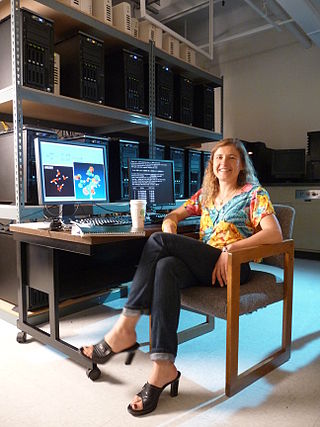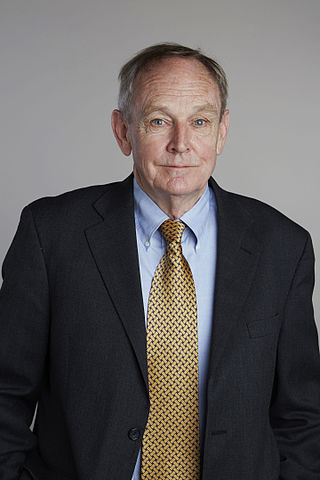Related Research Articles
Computational chemistry is a branch of chemistry that uses computer simulation to assist in solving chemical problems. It uses methods of theoretical chemistry, incorporated into computer programs, to calculate the structures and properties of molecules, groups of molecules, and solids. It is essential because, apart from relatively recent results concerning the hydrogen molecular ion, the quantum many-body problem cannot be solved analytically, much less in closed form. While computational results normally complement the information obtained by chemical experiments, it can in some cases predict hitherto unobserved chemical phenomena. It is widely used in the design of new drugs and materials.

Sir John Anthony Pople was a British theoretical chemist who was awarded the Nobel Prize in Chemistry with Walter Kohn in 1998 for his development of computational methods in quantum chemistry.
Quantum chemistry, also called molecular quantum mechanics, is a branch of physical chemistry focused on the application of quantum mechanics to chemical systems, particularly towards the quantum-mechanical calculation of electronic contributions to physical and chemical properties of molecules, materials, and solutions at the atomic level. These calculations include systematically applied approximations intended to make calculations computationally feasible while still capturing as much information about important contributions to the computed wave functions as well as to observable properties such as structures, spectra, and thermodynamic properties. Quantum chemistry is also concerned with the computation of quantum effects on molecular dynamics and chemical kinetics.

Robert Ghormley Parr was an American theoretical chemist who was a professor of chemistry at the University of North Carolina at Chapel Hill.

Theoretical chemistry is the branch of chemistry which develops theoretical generalizations that are part of the theoretical arsenal of modern chemistry: for example, the concepts of chemical bonding, chemical reaction, valence, the surface of potential energy, molecular orbitals, orbital interactions, and molecule activation.

Erich Armand Arthur Joseph Hückel was a German physicist and physical chemist. He is known for two major contributions:

John Clarke Slater was an American physicist who advanced the theory of the electronic structure of atoms, molecules and solids. He also made major contributions to microwave electronics. He received a B.S. in physics from the University of Rochester in 1920 and a Ph.D. in physics from Harvard in 1923, then did post-doctoral work at the universities of Cambridge (briefly) and Copenhagen. On his return to the U.S. he joined the physics department at Harvard.
Chemical physics is a subdiscipline of chemistry and physics that investigates physicochemical phenomena using techniques from atomic and molecular physics and condensed matter physics; it is the branch of physics that studies chemical processes from the point of view of physics. While at the interface of physics and chemistry, chemical physics is distinct from physical chemistry in that it focuses more on the characteristic elements and theories of physics. Meanwhile, physical chemistry studies the physical nature of chemistry. Nonetheless, the distinction between the two fields is vague, and scientists often practice in both fields during the course of their research.
In molecular physics, the Pariser–Parr–Pople method applies semi-empirical quantum mechanical methods to the quantitative prediction of electronic structures and spectra, in molecules of interest in the field of organic chemistry. Previous methods existed—such as the Hückel method which led to Hückel's rule—but were limited in their scope, application and complexity, as is the Extended Hückel method.
Roy McWeeny was a British academic physicist and chemist.

The Journal of Physical Chemistry A is a scientific journal which reports research on the chemistry of molecules - including their dynamics, spectroscopy, kinetics, structure, bonding, and quantum chemistry. It is published weekly by the American Chemical Society.
Rodney Joseph Bartlett is Graduate Research Professor of Chemistry and Physics, University of Florida, Gainesville, USA.

Henry Frederick "Fritz" Schaefer III is a computational and theoretical chemist. He is one of the most highly cited chemists in the world, with a Thomson Reuters H-Index of 121 as of 2020. He is the Graham Perdue Professor of Chemistry and Director of the Center for Computational Chemistry at the University of Georgia. Before becoming professor at Georgia he was professor at University of California, Berkeley and in 2004, he became Professor of Chemistry Emeritus, at UC Berkeley
The National Academy of Sciences Award in Chemical Sciences is awarded for innovative research in the chemical sciences that in the broadest sense contributes to a better understanding of the natural sciences and to the benefit of humanity.
Semi-empirical quantum chemistry methods are based on the Hartree–Fock formalism, but make many approximations and obtain some parameters from empirical data. They are very important in computational chemistry for treating large molecules where the full Hartree–Fock method without the approximations is too expensive. The use of empirical parameters appears to allow some inclusion of electron correlation effects into the methods.
Ab initio quantum chemistry methods are computational chemistry methods based on quantum chemistry. The term ab initio was first used in quantum chemistry by Robert Parr and coworkers, including David Craig in a semiempirical study on the excited states of benzene. The background is described by Parr. Ab initio means "from first principles" or "from the beginning", implying that the only inputs into an ab initio calculation are physical constants. Ab initio quantum chemistry methods attempt to solve the electronic Schrödinger equation given the positions of the nuclei and the number of electrons in order to yield useful information such as electron densities, energies and other properties of the system. The ability to run these calculations has enabled theoretical chemists to solve a range of problems and their importance is highlighted by the awarding of the Nobel prize to John Pople and Walter Kohn.

Anna I. Krylov is a Professor of Chemistry at the University of Southern California (USC), working in the field of theoretical and computational quantum chemistry. She is the inventor of the spin-flip method. Krylov is the president of Q-Chem, Inc. and an elected member of the International Academy of Quantum Molecular Science and the Academia Europaea.

William Hughes Miller is an American professor at the University of California, Berkeley and a leading researcher in the field of theoretical chemistry.
Michael Peter Barnett was a British theoretical chemist and computer scientist. He developed mathematical and computer techniques for quantum chemical problems, and some of the earliest software for several other kinds of computer application. After his early days in London, Essex and Lancashire, he went to King's College, London, in 1945, the Royal Radar Establishment in Malvern in 1953, IBM UK in 1955, the University of Wisconsin Department of Chemistry in 1957, and the MIT Solid State and Molecular Theory Group in 1958.
References
- ↑ Robert G. Parr and Bryce L. Crawford. National Academy of Sciences Conference on Quantum-Mechanical Methods in Valence Theory, Proceedings of the National Academy of Sciences, 38, 547--554, 1952.
- ↑ J.C. Light, American Conference on Theoretical Chemistry: Introductory Remarks. Journal of Physical Chemistry, 86, 2111-12, 1982
- ↑ R.G. Parr, The Genesis of a Theory, International Journal of Quantum Chemistry, 37, 327--347, 1996.